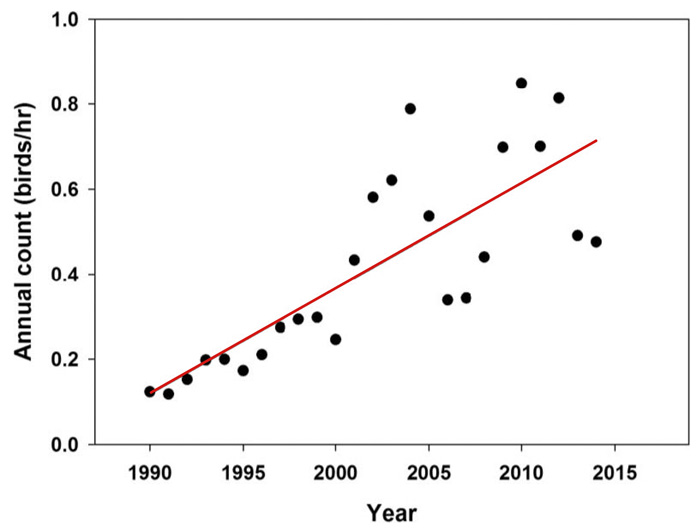| Follow @co2science |
Paper Reviewed
Probst, J.C., Therrien, J.-F., Goodrich, L.J. and Bildstein, K.L. 2017. Increase in numbers and potential phenological adjustment of Ruby-throated Hummingbirds (Archilochus colubris) during autumn migration at Hawk Mountain Sanctuary, eastern Pennsylvania, 1990-2014. The Wilson Journal of Ornithology 129: 360-364.
The potential impacts of climate change on birds have long stirred interest in the scientific community, evidenced by the many papers we have reviewed on the subject (see here, here and here).
The latest in this long line of research comes from Probst et al. (2017), who analyzed 25 years of count data for the Ruby-throated Hummingbird (Archilochus colubris) obtained at the Hawk Mountain Sanctuary on the Kittatinny Ridge of the central Appalachians, eastern Pennsylvania. The data were collected daily, weather permitting, each year from August 15 to December 15 over the period 1990-2014.
As shown in the figure below, annual bird counts increased significantly over the period of study, rising by 8 percent annually. Additionally, the scientists report there was a significant 1.3 day per decade increase in the date of the first 5% of bird passage, although the median, average and 95% passage dates did not vary statistically over time. Thus, autumn bird passage duration (number of days between 5% and 95% of the flight) remained relatively constant over the 25-year period.
In light of the above findings, it would thus appear that the number of autumn bird counts has certainly not suffered from the past 25 years of climate change that they have endured. Indeed, they appear to have greatly benefited!

Figure 1. Annual counts of Ruby-throated Hummingbirds at Hawk Mountain Sanctuary, Pennsylvania over the period 1990-2014. Source: Probst et al. (2017).




